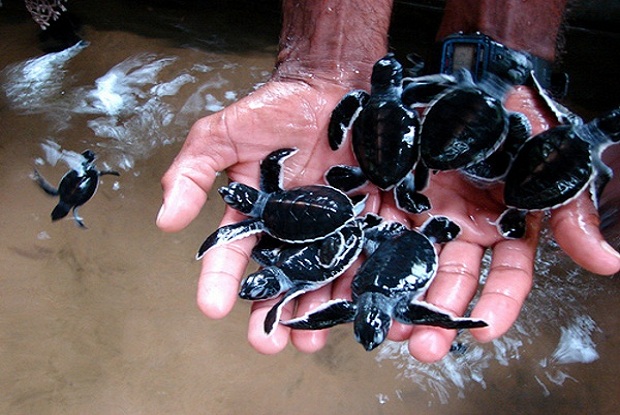Sri Lanka is a vital habitat for sea turtles. It has been observed that five of the seven endangered species come to the shores of Sri Lankan beaches to lay their eggs. Watching adult and newly-hatched turtles is a popular attraction for tourists in Sri Lanka, hence Blue Lanka Tours always include this activity in all their Sri Lanka holiday itineraries. Throughout the south western coastline of Sri Lanka, there are several turtle hatcheries that conserve sea turtles. Kosgoda, Bentota, Induruwa, Hikkaduwa, Galle, Unawatuna and Koggala are a few towns where you can experience an encounter with turtles.
Origins: The Sea Turtle Sanctuary and Research Centre in Sri Lanka was founded in 1978 and has been in operation for nearly 40 years now. The Kosgama Turtle Hatchery was founded by a doctor and a research scientist and is the oldest and biggest turtle conservation project in the island. All turtle hatcheries are non-profit organizations and source their funding through donations and by selling entrance tickets to visitors.
Below are the five out of seven endangered turtle species that can be seen at turtle hatcheries in Sri Lanka:
- Loggerhead – Endangered
- Green turtle – Endangered
- Leatherback – Critically Endangered
- Hawksbill – Critically Endangered
- Olive ridley – Vulnerable
These turtles are being hatched from the captured turtle eggs, trained for three days to make them strong enough to survive in the sea, and then released into the Indian Ocean as three day old baby turtles. While most people are afraid of reptiles, one should be questioned as follows:
Did you know that turtles are also reptiles?!
The oldest known turtle dates back to 220 million years ago. Hence turtles are one of the oldest reptile groups in the world. They are more ancient than other living lizards, crocodiles and snakes.
There are two kinds of turtles: one is the Chelonii and the other is the Testudines. They are differentiated by a special boney shell enveloped from their ribs, which acts as a shield. Both categories have existing and extinct species as well.
Like all other reptiles, turtles have varying internal temperatures, depending on the ambient environment. Although many turtle species live in or around water, they breathe in air and do not lay eggs underwater.
Turtle hatcheries in Sri Lanka also treat injured and sick turtles until they are strong enough to go back into the sea. Turtle eggs are purchased from fishermen and authorities from the hatchery bury these eggs in sea sand until they hatch. Dead turtles are also preserved at the hatchery for the purpose of public viewing. The Kosgoda Turtle Hatchery alone has managed to release 3.5 million baby turtles to the Indian Ocean as of May 2013 (Asian Tribune reports).

